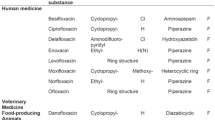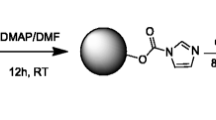Abstract
Histamine (HA) is a biogenic amine associated with allergies and food poisoning. It is an important indicator of food freshness and quality. In recent years, a series of medical negligence cases have been reported to be related to the intravenous injection of antibiotics produced via fermentation with fish peptone due to HA contamination. To detect HA efficiently, mouse monoclonal antibody was developed. An enzyme-linked immunosorbent assay (ELISA) and a chemiluminescence enzyme immunoassay (CLEIA) were developed and compared with conventional HPLC analysis. Both immunoassays showed low cross-reactivity, low 50% inhibitive concentration (IC50; 1.2 μg/mL and 1.1 μg/mL), low limits of detection (LODs, IC10; 89.0 ng/mL and 73.4 ng/mL), and appreciable recoveries in spiked foods and drugs (from 73.4 to 131.0% and from 77.0 to 119.0%, espectively), demonstrating that the developed methods are sensitive, specific, fast, and reliable for HA detection in complicated real samples.

Graphical abstract




Similar content being viewed by others
References
Gagic M, Jamroz E, Krizkova S, Milosavljevic V, Kopel P, Adam V. Current trends in detection of histamine in food and beverages. J Agr Food Chemi. 2019;67(3):773–83.
Alizadeh N, Kamalabadi M, Mohammadi A. Determination of histamine and tyramine in canned fish samples by headspace solid-phase microextraction based on a nanostructured polypyrrole fiber followed by ion mobility spectrometry. Food Anal Methods. 2017:1–8.
Lin L, Xu ZL, Yang JY, Xiao ZL, Li YJ, Beier RC, et al. Synthesis of novel haptens and development of an enzyme-linked immunosorbent assay for quantification of histamine in foods. J Agr Food Chemi. 2014;62(51):12299–308.
Martuscelli M, Arfelli G, Manetta AC, Suzzi G. Biogenic amines content as a measure of the quality of wines of Abruzzo (Italy). Food Chem. 2013;140(3):590–7.
Lehane L, Olley J. Histamine fish poisoning revisited. Int J Food Microbiol. 2000;58(1):1–37.
Gaudiano MC, Valvo L, Rodomonte AL. A Q-TOF LC/MS method for identification and quantitation of histamine in the antibiotic gentamicin at ppm level: validation and uncertainty evaluation. J Pharm Biomed Anal. 2019;162:158–63.
Guidelines for the dosing and monitoring of gentamicin, vancomycin and teicoplanin 2010. https://www.ruh.nhs.uk/For_Clinicians/departments_ruh/Pathology/documents/haematology/Dosing_of_Gentamicin_Vancomycin_and_Teicoplanin.pdf. Accessed March 2010.
Hörman A. Regulation (EC) no 2073/2005 on microbiological criteria for foodstuffs 2008. Available from: http://www.sice.oas.org/TPD/CACM_EU/Negotiations/IIround_microbiological_e.pdf. Accessed 26 February 2008.
GB 5009.208-2016: determination of biogenic amines in food 2016. http://www.doc88.com/p-3387486346572.html. Accessed 23 June 2017.
Fish and fisheries products hazards and controls guidance 4th Ed 2019. https://www.fda.gov/downloads/Food/GuidanceRegulation/UCM251970.pdf. Accessed August 2019.
FAO. Public health risks of histamine and other biogenic amines from fish and fishery products 2013. http://www.fao.org/fileadmin/user_upload/agns/pdf/Histamine/Histamine_AdHocfinal.pdf. Accessed 23 July 2012.
Ricardo Jorge DO. Heterogeneous and homogeneous immunoassays for drug analysis. Bioanalysis. 2014;6(21):2877–96.
Hammar E, Berglund A, Hedin A, Norrman A, Rustas K, Ytterström U, et al. An immunoassay for histamine based on monoclonal antibodies. J Immunol Methods. 1990;128(1):51–8.
Guesdon JL, Chevrier D, Mazié JC, David B, Avrameas S. Monoclonal anti-histamine antibody. Preparation, characterization and application to enzyme immunoassay of histamine. J Immunol Methods. 1986;87(1):69–78.
Luo L, Xu ZL, Yang JY, Xiao ZL, Wang H. A sensitivity-enhanced heterologous immunochromatographic assay based on monoclonal antibody for the rapid detection of histamine in saury samples. RSC Adv. 2015;5(96):78833–40.
Sandra P, Jordi B, Esteve F. Amperometric biosensor for the determination of histamine in fish samples. Food Chem. 2013;141(4):4066–72.
Patange SB, Mukundan MK, Kumar KA. A simple and rapid method for colorimetric determination of histamine in fish flesh. Food Control. 2005;16(5):465–72.
CHIN KDH, Koehler PE. Identification and estimation of histamine, tryptamine, phenethylamine and tyramine in soy sauce by thin-layer chromatography of dansyl derivatives. J Food Sci. 2010;48(6):1826–8.
Altieri I, Semeraro A, Scalise F, Calderari I, Stacchini P. European official control of food: determination of histamine in fish products by a HPLC–UV-DAD method. Food Chem. 2016;211:694–9.
Poli C, Laurichesse M, Rostan O, Rossille D, Jeannin P, Drouet M, et al. Comparison of two enzymatic immunoassays, high resolution mass spectrometry method and radioimmunoassay for the quantification of human plasma histamine. J Pharm Biomed Anal. 2016;118:307–14.
Manz G, Booltink E. Validation study of a HistaSure™ ELISA (Fast Track) for the determination of histamine in fish samples. J AOAC Int. 2014;97(6):1601–14.
Yuan B, C-X A, Yuan L, Gao W, J-P H, Chen J, et al. Preparation of monoclonal antibody of anti-feline calicivirus and establishment of double-antibody sandwich enzyme-linked immunosorbent assay detecting method. Genet Mol Res. 2014;13(3):7388–97.
Purification of immunoglobulins and preparation of Fab fragments. Laboratory Techniques in Biochemistry & Molecular Biology. 1985:95–121.
Kim JK, Adam A, Loo JCK, Ong H. A chemiluminescence enzyme immunoassay (CLEIA) for the determination of medroxyprogesterone acetate in human serum. J Pharm Biomed Anal. 1995;13(7):885–91.
Vagelis E, Brett MM, Chrissanthy P, Stathis F, Tom N. Changes in histamine and microbiological analyses in fresh and frozen tuna muscle during temperature abuse. Food Addit Contam. 2007;24(8):820–32.
Kim SH, Price RJ, Morrissey MT, Field KG, Wei CI, An H. Histamine production by Morganella morganii in mackerel, albacore, Mahi-mahi, and salmon at various storage temperatures. J Food Sci. 2010;67(4):1522–8.
Rapid implementation of the monograph products of fermentation (1468) 2018. https://www.edqm.eu/sites/default/files/supplementcomments96_e.pdf. Accessed June 2018.
Henao CMG, Morales CIH, Villa RC, Henao AMC. Gentamicin induced anaphylaxis, a case report. World Allergy Organ J. 2015;8(S1):A269.
Gentamicin: potential for histamine-related adverse drug reactions with some batches Medicines and Healthcare products Regulatory Agency. https://www.gov.uk/drug-safety-update/gentamicin-potential-for-histamine-related-adverse-drug-reactions-with-some-batches. Accessed 24 November 2017.
Canada Health Gentamicin injection USP (10 mg/mL and 40 mg/mL) – potential for adverse reactions with 12 lots contaminated with histamine 2017. http://www.healthycanadians.gc.ca/recall-alert-rappel-avis/hc-sc/2017/63768a-eng.php. Accessed 3 July 2017.
Health ADo. Recall - potential for allergic reactions due to higher than expected amounts of histamine. https://www.tga.gov.au/alert/gentamicin-injection-bp-80-mg-2-ml-steriluer. Accessed 6 October 2017.
Technology AR. Information on gentamicin-Histamin products 2018. http://www.irvinesci.com/news/information-on-gentamicin-histamin-products. Accessed 29 January 2018.
Committee for Medicinal Products for Veterinary Use (CVMP) meeting of 17–19 April 2018 2018. Available from: https://www.ema.europa.eu/en/news/committee-medicinal-products-veterinary-use-cvmp-meeting-17-19-april-2018. Accessed 19 April 2018.
Becker K, Southwick K, Reardon J, Berg R, Maccormack JN. Histamine poisoning associated with eating tuna burgers. JAMA. 2001;285(10):1327–30.
Kan K, Ushiyama H, Shindo T, Uehara S, Yasuda K. Outbreak of histamine poisoning due to ingestion of fish, “Abura-sokomutsu”. Lepidocybium flavobrunneum. J Food Hyg Soc Jpn. 2000;41(2):116–21.
Macan J, Vucemilović A, Turk R, Medugorac B, Milković-Kraus S, Gomzi M, et al. Occupational histamine poisoning by fish flour: a case report. Occup Med. 2000;50(1):22.
Tursi A, Modeo ME, Cascella AM, Cuccorese G, Spinazzola AM, Miglietta A. Scombroid syndrome with severe and prolonged cardiovascular involvement. Recenti Prog Med. 2001;92(9):537.
Hall M. Something fishy: six patients with an unusual cause of food poisoning! Emerg Med (Fremantle). 2010;15(3):293–5.
Tsai YH, Hsieh HS, Chen HC, Cheng SH, Chai TJ, Hwang DF. Histamine level and species identification of billfish meats implicated in two food-borne poisonings. Food Chem. 2007;104(4):1366–71.
Histamine poisoning caused by tuna in Luxembourg. 2018. https://www.foodnavigator.com/Article/2018/05/28/Tuna-linked-to-foodborne-outbreak-inLuxembourg. Accessed 28 May 2018.
Hungerford J, Wu WH. Comparison study of three rapid test kits for histamine in fish: BiooScientific MaxSignal enzymatic assay, Neogen Veratox ELISA, and the Neogen reveal histamine screening test. Food Control. 2012;25(2):448–57.
Rahimi E, Nayebpour F, Alian F. Determination of histamine in canned tuna fish using ELISA method. AEJTS. 2012;4(2):64–6.
Funding
This work is financially supported by the National Natural Science Foundation of China (Nos. 31572556 and 31873006); the Key Program for International S&T Cooperation Project of Shaanxi Province (No. 2017KW-ZD-10); the Ministry of Education and Science of the Russian Federation (No. RFMEFI60417X0198); the FCT I.P, the Ministério da Ciência, Tecnologia e Ensino Superior (MCTES); and the European Regional Development Fund (ERDF) (No. POCI-01-0145-FEDER-007569).
Author information
Authors and Affiliations
Corresponding author
Ethics declarations
Conflict of interest
The authors declare that they have no conflict of interest.
Ethics statement
All procedures performed in this study involving mice were in accordance with the experimental animal regulation of China and according to the measures for the administration of experimental animal in Shaanxi Province concerning protection of animals used for scientific purposes. All experimental animal protocols were reviewed and approved by the Ethics Committee of Shaanxi University of Technology for the use of laboratory animals (No. 2019-010).
Additional information
Publisher’s note
Springer Nature remains neutral with regard to jurisdictional claims in published maps and institutional affiliations.
Electronic supplementary material
ESM 1
(PDF 92.4 kb)
Rights and permissions
About this article
Cite this article
Xu, L., Zhou, J., Eremin, S. et al. Development of ELISA and chemiluminescence enzyme immunoassay for quantification of histamine in drug products and food samples. Anal Bioanal Chem 412, 4739–4747 (2020). https://doi.org/10.1007/s00216-020-02730-5
Received:
Revised:
Accepted:
Published:
Issue Date:
DOI: https://doi.org/10.1007/s00216-020-02730-5




